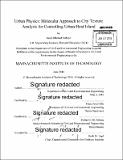| dc.contributor.advisor | Franz-Josef Ulm. | en_US |
| dc.contributor.author | Sobstyl, Jacob Michael | en_US |
| dc.contributor.other | Massachusetts Institute of Technology. Department of Civil and Environmental Engineering. | en_US |
| dc.date.accessioned | 2016-09-13T19:25:36Z | |
| dc.date.available | 2016-09-13T19:25:36Z | |
| dc.date.copyright | 2016 | en_US |
| dc.date.issued | 2016 | en_US |
| dc.identifier.uri | http://hdl.handle.net/1721.1/104324 | |
| dc.description | Thesis: S.M., Massachusetts Institute of Technology, Department of Civil and Environmental Engineering, 2016. | en_US |
| dc.description | Cataloged from PDF version of thesis. | en_US |
| dc.description | Includes bibliographical references (pages 126-135). | en_US |
| dc.description.abstract | Defined as intensification of urban air temperatures when compared to their rural surroundings common to cause negative externalities ranging from imperiling human health and comfort to amplifying energy costs and air pollution, Urban Heat Island (UHI) effect has been known to pose a severe burden on the 4.2 billion of people living in cities. With urban population expected to magnify by 2.5 billion by 2050 at an average annual rate of 72 million, ability to control UHI would have consequences of prodigious magnitude. While many UHI mitigation solutions for existent cities have already been established, due to complex nature of urban infrastructure, general and simple to follow design guidelines for building more sustainable urban environments are still missing. Here, we show that with appositeness of statistical physics, we are able to quantify prevailing patterns in cities to a set of few design parameters, which are directly related to UHI. Furthermore, we demonstrate that UHI has the potential to reduce energy bill and depress greenhouse gas emissions (GHG), and therefore cannot be simply generalized into negative realms. As such this work offers a simple to use tool for policy makers and planners to help residents save money on their energy bills, while setting cities and states on the right path towards achieving their GHG targets. | en_US |
| dc.description.statementofresponsibility | by Jacob Michael Sobstyl. | en_US |
| dc.format.extent | 135 pages | en_US |
| dc.language.iso | eng | en_US |
| dc.publisher | Massachusetts Institute of Technology | en_US |
| dc.rights | M.I.T. theses are protected by copyright. They may be viewed from this source for any purpose, but reproduction or distribution in any format is prohibited without written permission. See provided URL for inquiries about permission. | en_US |
| dc.rights.uri | http://dspace.mit.edu/handle/1721.1/7582 | en_US |
| dc.subject | Civil and Environmental Engineering. | en_US |
| dc.title | Urban physics : molecular approach to city texture analysis for controlling Urban Heat Island | en_US |
| dc.type | Thesis | en_US |
| dc.description.degree | S.M. | en_US |
| dc.contributor.department | Massachusetts Institute of Technology. Department of Civil and Environmental Engineering | |
| dc.identifier.oclc | 958279660 | en_US |

